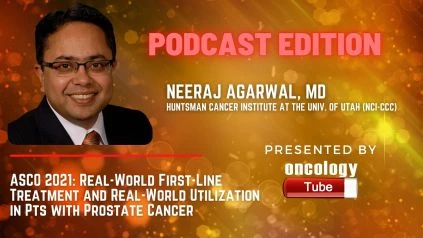Neeraj Agarwal, MD, is a Professor in the Division of Oncology, Department of Medicine, at the Huntsman Cancer Institute at University of Utah School of Medicine speaks about ASCO 2021 Abstracts – Health-related quality of life (HRQoL) and patient-reported outcomes at final analysis of the TITAN study of apalutamide (APA) versus placebo (PBO) in patients (pts) with metastatic castration-sensitive prostate cancer (mCSPC) receiving androgen deprivation therapy (ADT).
Link to Abstract:
https://meetinglibrary.asco.org/record/197750/abstract
Backstory:
In the phase 3 TITAN trial, APA was compared to PBO in patients with mCSPC who were receiving ADT. APA substantially improved overall survival (OS) and radiographic progression-free survival (RFS) compared to PBO in the main study with a median follow-up of 22.7 months (Chi NEJM 2019). (Agarwal Lancet Oncol 2019). The trial was not blinded, and those on PBO were able to switch to APA. APA substantially improved OS versus PBO in the final analysis, lowering the risk of mortality by 35% despite crossover, with a median follow-up of 44 months (Chi ASCO GU 2021). At the end of the study, we looked at HRQoL and treatment bother.
Methodologies:
Patients with mCSPC (N = 1052) were randomly assigned to either APA (240 mg QD; n = 525) or PBO (n = 527). ADT was given to all of the points. Brief Pain Inventory-Short Form (BPI-SF) and Functional Assessment of Cancer Therapy-Prostate were used to measure patient-reported outcomes (FACT-P). Through the completion of therapy, BPI was performed for 7 days in a row (Days -6 to 1 of each 28-day cycle [C]) (EOT). At baseline (BL), C2-C7, and subsequently every other C until EOT, the FACT-P was completed. The mean scores for each treatment group and over time were provided. Kaplan-Meier techniques were used to calculate time to deterioration on BPI and FACT-P scores, which were then compared across groups using proportional hazards regression models.
Outcomes:
More than 62 percent of qualifying points per C completed the BPI through C32, and more than 50 percent finished the FACT-P through C31. Pts were asymptomatic with good BL HRQoL: median scores on the 0-10 worst pain severity scale (BPI) were 1.1 (APA) and 1.0 (PBO); median scores on the 0-156 HRQoL scale (FACT-P total; higher score = greater HRQoL) were 113.0 (APA) and 113.3 (PBO) (PBO). In both groups, low BL BPI values remained consistent over time. In the APA and PBO groups, positive BL FACT-P ratings did not deteriorate significantly over time. In any BPI or FACT-P score, there were no significant differences between groups in median time to degradation (Table). At least 86 percent (APA) and 85 percent (PBO) of pts were “not at all†or “just a little bit†disturbed by side effects at each C. At BL, 76 percent (APA) and 72 percent (PBO) had good energy levels (reporting a lack of energy “not at all” or “a little bit”). For > 78 percent (APA) and > 71 percent (PBO) of pts, energy levels were steady or improved at each C.
Observations:
In the final analysis of TITAN, the addition of APA to ADT resulted in a survival benefit without a significant increase in patient-reported side effects or a reduction in HRQoL when compared to PBO in patients with mCSPC.
Clinical trial information: NCT02489318:
http://clinicaltrials.gov/show/NCT02489318

